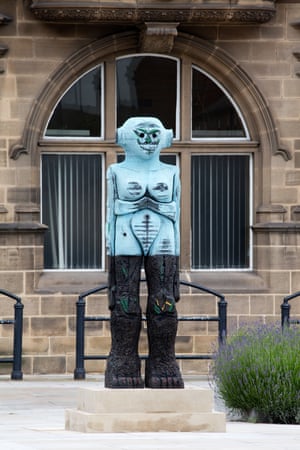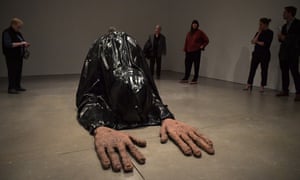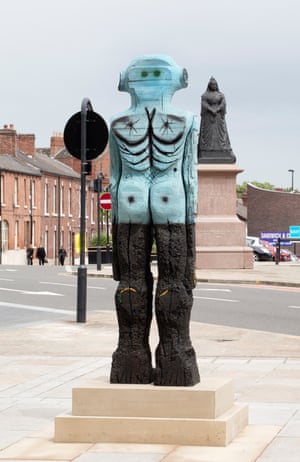She has commanded the rooftop of New York’s Metropolitan Museum, and has exported her distressed sculptures around the world, but only now is the UK waking up to the work of Huma Bhabha. It’s not the first time she has been late to the party. “It took me a long time to get any recognition at all,” says the artist, who was into her 40s before she made her first sale. “But, when you get recognition much later, you have a lot of time to do whatever the hell you want, which leads to a better understanding of what your work is.”
In the Yorkshire city of Wakefield, the destination for her first commissioned installation in the UK, shoppers seemed a little unsure what to make of the strange humanoid figure that is currently occupying of a stretch of pavement between the town hall and a first world war memorial. And it’s true that the two-tone bronze statue, commissioned as a centrepiece of the Yorkshire Sculpture International, looks oddly tentative, as if it has been beamed in from some intergalactic battlefield in an episode of Doctor Who and can’t quite believe where it has landed.
Bhabha works in many media – from sculpture to drawing and photography – but, once you have seen her work, there is no mistaking it. Born in Pakistan, she has spent most of her adult life in the US, where she now lives in upstate New York with her artist husband Jason Fox and their two dogs. She is an obsessive snapper-up of abandoned objects and flits across cultures, drawing from science fiction movies as well as from ancient mythologies.

At the Met, her two exhibits included an 18ft-long version of one of her best-known pieces, Benaam (Urdu for “unnamed”) – a prone figure that could be a veiled woman at prayer, and which she has used previously to memorialise the victims of the Iraq and Afghanistan wars. “It’s about the endless wars and the endless killings of innocent people,” she says. Two years ago, the Tate became the first British national gallery to buy her work, investing in a 2006 cyclops head called A Man of No Importance.
The Wakefield piece is titled Receiver, and though at first it appears to be a space traveller still plugged into its earphones, the closer you look, the more it begins to resemble an ancient Hindu icon washed ashore after centuries at sea. It is androgynous and faces both ways, with two pairs of arms, one down by its side, the other folded across its belly. “I like that it’s at a crossroads so it’s almost like a traveller, a receiver, with people driving, walking, stopping by,” says Bhabha. But no sooner had it settled into Wakefield than it (or, rather, an identical copy) popped up again in Regent’s Park, London, where it has a rather different vibe: as part of Frieze Sculpture 2019, it’s an exotic among exotics, which appears to have thrown a nearby monkey puzzle tree into a flailing tizzy with its badass reflection on the vulnerability of cork.
For all that the figure is cast in bronze, Receiver was originally carved from cork and Styrofoam, hence its pitted brown legs and its strafed blue torso and head. Bhabha’s studio is full of found materials that might one day come in useful, and she is unafraid to capitalise on happy accidents. The Unnamed materialised out of a lump of clay and the black plastic sheet she was using to keep it moist and workable. A Man of No Importance is a mashup of materials including animal bones and a car headlight.

She made her first cork sculpture in 2008. “There was a stationery store going out of business close by where I live,” she says. “He was an old man and the store had been around since the 1960s. He had these blocks that he would use for display. It was 10 to 15 dollars for a bunch of cork. So I bought it, though I didn’t know what I was going to do with it.”
At the time she hadn’t done any carving, “so it lay around in my studio, and I thought the best thing to do was to glue the pieces together into a column and see if I could carve it. Then one thing led to another and he sold me all he had.” When her supplies of cork ran out it struck her that foam panels used for packing and insulation had some of the same qualities. “I realised they looked very good together, so I just kept doing it.”
She’s reluctant to talk politics, preferring to allow her work to speak for itself. Receiver certainly fulfils Yorkshire curator Clare Lilley’s promise of “something bronze and distressed, referring to the turbulent world around us”. But there is also a pragmatic politics in Bhabha’s rescue of commonplace materials and abandoned objects, which is reflected in the siting of the piece in the city centre, far from any other exhibits. It stands close to Wakefield College, which is part of a collaboration between the Yorkshire sculpture festival and local schools and universities to get sculpture back into education after years of being sidelined because of the price of materials. This is a crossroads through which students pass, their heads encased in earphones like Receiver’s.

Bhabha’s work is a demonstration that sculptural ambition doesn’t have to cost the Earth. Unusually in the world of monumental installations, she does all her work herself, only recently hiring an assistant to glue the blocks together. Receiver was cast in London, and she travelled there to distress the bronze further with bright daubs of paint that could be graffiti or tribal markings. “I’m not a purely conceptual artist. I’m a formalist and very much someone who works with my hands,” she says. “I’m not interested in putting objects together or illustrating a theory. I’m a traditional female artist. I’ve been making art for a decent amount of time and I like the fact that my work looks like my work.”
Importantly, for the would-be sculptors of Wakefield and beyond, she is adept at playing with the illusion of grandeur: “I’m interested in the idea of monuments, but that doesn’t necessarily mean they have to be on a monumental scale.”
• Huma Bhabha’s Receiver is outside County Hall, Wakefield, until 29 September and at Frieze Sculpture, Regent’s Park, London, until 6 October.
